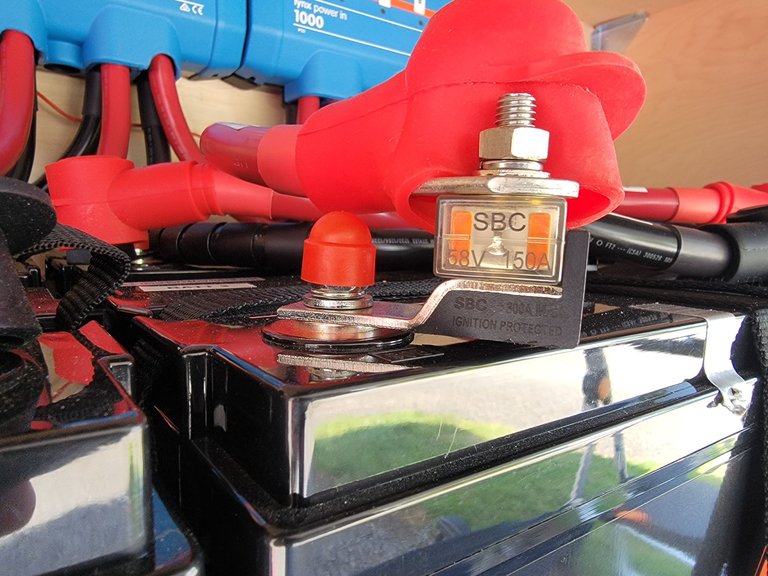Individually Fused Batteries

To further enhance the safety and reliability of my battery system, I installed a 150-amp fuse onto the positive terminal of each battery. This crucial safety measure ensures that in the event of a single battery failure, a chain reaction will not occur, thereby protecting the entire battery bank from potential damage.
Here are the key points and benefits of this setup:
Individual Battery Protection: By installing a 150-amp fuse on each battery’s positive terminal, I have added a layer of protection for each individual battery. If any battery experiences a short circuit or another issue that causes it to draw excessive current, the fuse will blow, effectively isolating the faulty battery from the rest of the system. This prevents the failure from affecting the other batteries, thereby preserving the integrity of the entire battery bank.
Preventing Chain Reactions: Without these fuses, a single battery failure could potentially lead to a dangerous chain reaction, where the increased load and heat from the failed battery could cause adjacent batteries to fail as well. The fuses act as a fail-safe, ensuring that any issue with one battery does not propagate through the system.
Safety Enhancement: The fuses help in preventing potential fire hazards. Overcurrent conditions can generate excessive heat, leading to the risk of fire. By blowing and cutting off the current, the fuses mitigate this risk, making the entire system much safer.
System Reliability: In a high-capacity battery system like mine, reliability is crucial. The 150-amp fuses ensure that even if one battery goes down, the rest of the batteries can continue to operate normally. This redundancy increases the overall reliability of the power system, ensuring that I have a consistent power supply even in the event of a failure.
Easy Maintenance and Troubleshooting: Having individual fuses makes it easier to identify and isolate problems. If a fuse blows, it’s a clear indicator that there’s an issue with the corresponding battery. This makes troubleshooting simpler and more straightforward, allowing for quick repairs and minimal downtime.
Optimized Performance: By protecting each battery individually, the fuses help maintain the optimal performance of the entire battery bank. Faulty batteries can be quickly identified and replaced without affecting the rest of the system, ensuring that the power supply remains stable and efficient.
Current Limiting: The 150-amp rating of the fuses is carefully chosen based on the specifications of the batteries and the expected load. This rating ensures that the batteries can operate within their safe limits while providing sufficient current for my needs. The fuses act as a safeguard against unexpected surges that could otherwise damage the batteries.
Installing these 150-amp fuses was a critical step in ensuring the longevity and safety of my LiFePO4 battery setup. By taking this precaution, I have significantly reduced the risk of catastrophic failures and ensured a more reliable and efficient power system for my trailer.
Note: I wrote the initial paragraphs and then enhanced them with the help of ChatGPT.
Very smart move to install individual fuses on each battery brother. It'll ensure safety preventing any single battery issue from affecting the whole system. You definitely prioritize reliability and safety in your setup. Good work brother have some !BEER !PIZZA
Thanks!
You're always welcome brother
Smart move with the fuses. Last thing you need is massive battery overheating and explosion. It's good to see you back posting! It's been awhile!
I bet that trailer turning out nicely!
Yup it sure has. Thanks, I'm glad that you agree!
That's beauty! 👊😉😎 looks way better that the row of car batteries that I would have. (if i even had some.. future plans..)
Thanks, car batteries are no bueno
yes. 😉✌️
good technical hack
$PIZZA slices delivered:
(1/5) @theringmaster tipped @joshman